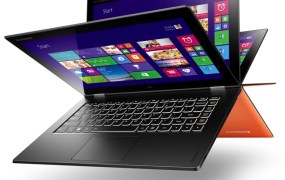Lenovo had two big choices after releasing its troubled IdeaPad Yoga last year: Explore the idea of computers that can flip and twist for different functionality even more (something the company calls “multimode”), or give up on it idea entirely.
Today, it’s clear that Lenovo isn’t running away from its multimode dreams. The company announced two new Yoga laptops, the Yoga 2 Pro and the more professional ThinkPad Yoga, as well as new Flex laptops whose screens can flip in a single direction. Additionally, Lenovo introduced a new high-end smartphone, the Vibe X, and the thin S5000 Android tablet.
[aditude-amp id="flyingcarpet" targeting='{"env":"staging","page_type":"article","post_id":808329,"post_type":"story","post_chan":"none","tags":null,"ai":false,"category":"none","all_categories":"mobile,","session":"B"}']The Yoga 2 refines the original’s wacky adjustable display innovation: You can use it like a normal laptop; twist the screen around so the keyboard is behind it (“stand mode”); stand the device on both the display and keyboard edges to be used like an artist’s easel (“tent mode”); and of course, you can twist the screen around to cover the keyboard and use the Yoga like a tablet.
Thanks to Windows 8’s touchscreen focus, I was intrigued by Lenovo’s first attempt to build a versatile computer. But the original Yoga was too big and bulky to be usable, and it wasn’t very fast either. The Yoga 2 seems to fix all of those problems: It weighs around 3 pounds (slight more than the 13-inch MacBook Air), measures 15.5 millimeters thick, and runs Intel’s new fourth-generation “Haswell” Core i7 processors.
AI Weekly
The must-read newsletter for AI and Big Data industry written by Khari Johnson, Kyle Wiggers, and Seth Colaner.
Included with VentureBeat Insider and VentureBeat VIP memberships.
The Yoga 2 sticks with the 13.3-inch screen size of the original, but the resolution is a significantly higher 3200 by 1800 pixels (packing in four times as many pixels as the first Yoga).
Even more interesting is what Lenovo is doing with the ThinkPad Yoga: It’s a more professional stab at a multimode computer. It also has the ability to completely make the keys flat when you twist the display around in tablet mode. Its 12.5-inch 1080p resolution display won’t be as sharp as the Yoga 2 Pro’s, but it should make it a slightly more portable option.
Both new Yoga laptops explore the many different ways we can use our laptops now, since they’re touchscreen enabled and far lighter than before. I’m not sure the Yoga configurations are the most compelling options for consumers (personally I’m still waiting for the perfect laptop/tablet hybrid), but it’s nice to see that companies like Lenovo aren’t afraid to experiment with new computing models. With the traditional PC market floundering, computer makers have to explore new computing styles to survive.
The Flex laptops aren’t as versatile as the Yoga lineup: They can only be used in “stand mode,” but they’re also far cheaper. They sport 14.1 and 15.6 inch displays with resolutions of 1366 by 768 (surprisingly low these days, especially given those screen sizes), and full HD 1920 by 1080 pixels.
Lenovo also unveiled the Flex 20, a smaller version of its 27-inch behemoth Horizon table PC, which can be used like a desktop, or flipped down flat. The Flex 20 could be a cool device to have in office conference rooms, but with a low 1600 by 900 display resolution, it’s not really ideal for an everyday computer.
Now that Lenovo is the second largest smartphone maker in China, it needs to keep upping the ante with its smartphones to stay relevant. The company’s new Vibe X Android phone features a 5-inch screen with a 1080p display, a thin design with a “fabric-like” back cover, and high resolution cameras (13 megapixels for the rear, and a surprisingly large 5 megapixels for the front camera).
[aditude-amp id="medium1" targeting='{"env":"staging","page_type":"article","post_id":808329,"post_type":"story","post_chan":"none","tags":null,"ai":false,"category":"none","all_categories":"mobile,","session":"B"}']
The S5000 Android tablet has a similar thin design, a 7-inch screen, quad-core MediaTek processor running at 1.2 gigahertz, and a 1280 by 800 pixel resolution. Unfortunately for Lenovo, the new Asus-built Nexus 7 is a far more compelling tablet when it comes to specs and designs.
Lenovo says the Yoga 2 Pro will be available later this month starting at $1,099; the ThinkPad Yoga is coming in November for $949; and the Flex laptops will start at $630 and be available later this month (though the Flex 20 will go for a higher $890). The Vibe X will be available in China and other Lenovo smartphone markets (not the U.S. or Europe) in December, while the S5000 will come in the fourth quarter.
VentureBeat's mission is to be a digital town square for technical decision-makers to gain knowledge about transformative enterprise technology and transact. Learn More

